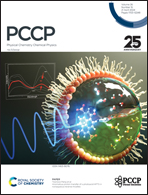Photophysics of a nucleic acid–protein crosslinking model strongly depends on solvation dynamics: an experimental and theoretical study†
Abstract
We present a combined experimental and theoretical study of the photophysics of 5-benzyluracil (5BU) in methanol, which is a model system for interactions between nucleic acids and proteins. A molecular dynamics study of 5BU in solution through efficient DFT-based hybrid ab initio potentials revealed a remarkable conformational flexibility – allowing the population of two main conformers – as well as specific solute–solvent interactions, which both appear as relevant factors for the observed 5BU optical absorption properties. The simulated absorption spectrum, calculated on such an ensemble, enabled a molecular interpretation of the experimental UV-Vis lowest energy band, which is also involved in the induced photo-reactivity upon irradiation. In particular, the first two excited states (mainly involving the uracil moiety) both contribute to the 5BU lowest energy absorption. Moreover, as a key finding, the nature and brightness of such electronic transitions are strongly influenced by 5BU conformation and the microsolvation of its heteroatoms.

- This article is part of the themed collection: Celebrating International Women’s day 2025: Women in physical chemistry


 Please wait while we load your content...
Please wait while we load your content...